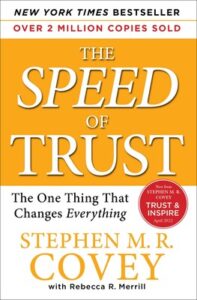Behavior #9: Clarify Expectations, page 192.
Summary: Behavior #9 – Clarify Expectations
- Disclose and reveal expectations.
- Discuss them.
- Validate them.
- Renegotiate them if need and possible.
- Don’t violate expectations.
- Don’t assume that expectations are clear and shared.
Behavior #9 – Clarify Expectations
“Almost all conflict is a result of violated expectations.” – Blaine Lee, Author
Expectations and Trust
- Behavior #9 – Clarify Expectations – is to create a shared vision and agreement about what is to be done upfront.
- This is one of those behaviors that people rarely pay enough attention to.
- I call it the behavior of prevention because if you focus on this one upfront, you will avoid heartaches and headaches later on.
- In contrast, if you don’t pay the price with this behavior upfront, you will have trust issues later, and they will affect speed and cost.
- Think about your own experience at work:
- How much time and effort is wasted because people are not clear on expectations?
- How often do people get off track on a project because leaders have not been sufficiently clear in describing the right path?
- How much “poor performance” is due to a lack of clarity around what is expected?
- And, what is the effect of all of this on trust?
- Clarify Expectations is based on the principles of clarity, responsibility, and accountability.
- The opposite of Clarify Expectations is to leave expectations undefined – to assume they’re already known, or to fail to disclose them so that there is no shared vision of the desired outcomes.
- Undefined expectations cause people to guess, wonder, or assume what expectations might be.
- Then, when results are delivered but not valued, everyone is disappointed, and trust, speed, and cost all take a hit.
- The counterfeit of Clarify Expectations is to create “smoke and mirrors” – to give lip service to clarifying expectations, while failing to pin down the specifics (results, deadlines, or dollars and cents) that facilitate meaningful accountability.
- Or it takes form as the ebb and flow of situational expectations that shift based on people’s memories or interpretations, or what is expedient or convenient at the time.
- One of the reasons why the impact of Clarify Expectations is so pervasive is that in every interaction – explicitly or implicitly, understood or not understood – there are expectations. And the degree to which these expectations are met or violated affects trust.
- Unclarified expectations are one of the primary reasons for broken trust. Violated expectations almost always get translated into trust issues.
Clarifying Expectations in Business
- Someone once asked me why we put business agreements in writing if we trust the other party. My response is that agreements identify and clarify expectations, which actually help preserve and even enhance trust over time.
It’s a Two-Way Street
- Keep in mind that clarifying expectations effectively is always a two-way street. People have to have the opportunity to push back, to help create an expectation that is realistic and will work from both points of view.
Making It Happen
- Over the years I have learned several important things about clarifying expectations:
- Quantify Everything:
- What result?
- By whom?
- By when?
- At what cost?
- How will we measure?
- How will we know when we have accomplished it?
- It’s wise to look at three variables – quality, speed, and cost.
- It’s almost always a choice: to get two, you have to give up one.
- When clarifying expectations, understand the tradeoffs involved.
- Sometimes it’s hard to clarify expectations – for example, to give someone a realistic delivery date instead of giving them a false promise of what they want to hear – it’s much better to do it up front than to disappoint them later.
Trust Tips
- Reaching the “sweet spot” in Clarify Expectations takes…
- Integrity (being honest and courageous about setting expectations and communicating with others).
- Intent to create expectations that represent a “win” for all involved.
- Capabilities, including the ability to organize the elements of the agreement, to set up accountability, and to execute with excellence.
- The ability to identify the desired results in a way that everyone involved understands
- If you’re on the left side of the curve, to some degree, you’re not being sufficiently clear.
- If you’re on the right side of the curve, you may be too detailed, too activity-oriented, too closed to interim adjustments if needed, or too distrusting.
Improving Your Ability to Clarify Expectations
- Check for clarity by asking a few simple questions:
- What have you understood from this conversation?
- As a result of our interaction, what do you see as your next step? What do you see as mine?
- Do you feel that others are clear regarding expectations?
- What can we do to make things more clear?
- The next time you have a project at work, create a clear project agreement in advance:
- Call everyone together and encourage them to express any ideas or concerns.
- Work to come up with a clear agreement that is realistic and represents a win for all stakeholders.



